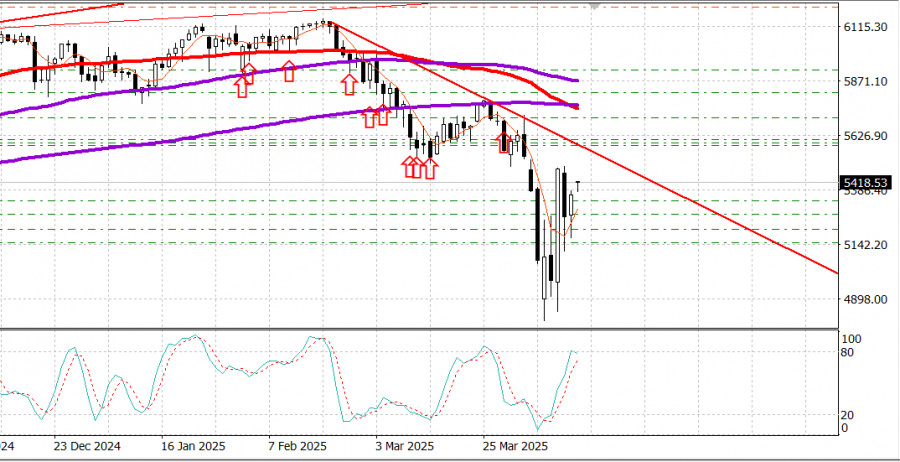See also


 14.04.2025 11:18 AM
14.04.2025 11:18 AMS&P500
Snapshot of the benchmark US stock indices on Friday:
* Dow Jones: +1.6%
* NASDAQ: +2.1%
* S&P 500: +1.8%, now at 5,268, trading in a range between 4,800 and 5,800.
Key point: Over the weekend, Trump announced he would exempt computers and smartphones from tariffs. As a reminder, current tariffs against China stand at 145% of the product's value. This news from Trump likely had a major impact on the US market, especially on stocks like Apple.
Some figures for context:
In 2024, US imports totaled $4.1 trillion, while exports stood at $3.2 trillion, resulting in a trade deficit of about $900 billion. It's clear why Trump is trying to do something about this.
US imports from China in 2024 were approximately $680 billion, while exports to China totaled only $150 billion—a trade deficit of about $430 billion with China alone. No wonder Trump's trade war has essentially become a battle with China.
The US stock market opened higher on Monday morning, as seen on the SPX (the S&P 500 equivalent that trades 24/5).
The US stock market on Friday, April 11
It took some time, but the stock market finally found its footing and made a solid recovery attempt after Thursday's steep losses, wrapping up what can only be described as a frantic week of trading.
Friday's session started off sluggishly despite some better-than-expected Q1 earnings results from:
* JPMorgan Chase (JPM $236.20, +$7.78, +3.4%)
* Wells Fargo (WFC $62.51, -$2.85, -4.5%)
* Morgan Stanley (MS $108.12, -$1.49, -1.4%)
* BlackRock (BLK $878.78, +$7.16, +0.8%)
* Bank of New York Mellon (BK $77.67, +$1.06, +1.4%)
Markets were uneasy due to the ongoing weakness in the US dollar. In the meantime, yields on US Treasury bonds were rising. A consumer sentiment index for April dropped amid inflation expectations at 6.7%—the highest since November 1981.
China retaliated with a 125% tariff on US imports in response to the US 145% tariff on Chinese goods. China also said it would ignore any further US tariff actions. Despite all this, stocks regrouped by mid-morning and continued to climb into the close.
This rebound coincided with a drop in the 10-year Treasury yield, from a peak of 4.58% to 4.45%. Yields ended the session up 10 basis points at 4.49%.
Other supporting factors included strength in mega-cap stocks, a reiteration from the White House press secretary that the President still hopes to reach a deal with China, and an FT report suggesting the Federal Reserve is ready to stabilize financial markets if conditions become too erratic.
Though both of these points were already widely known, they served as helpful reminders that the "Trump put" and the "Fed put" are still in play. The major indices ended the session at or near their intraday highs.
Notably, the Russell 2000 reversed an early 1.6% decline to finish up 1.6%. Though it lagged the market-cap-weighted S&P 500 (+1.8%), it slightly outperformed the equal-weighted S&P 500 (+1.5%).
While large-cap stocks were a key source of support throughout the session, buying broadened out as the day progressed. All 11 sectors of the S&P 500 closed the day higher, with gains of at least 1.1%:
* Materials: +3.0%
* Information technology: +2.6%
* Energy: +2.5%
Market breadth was clearly positive, with advancing stocks outnumbering decliners by more than 2-to-1 on the NYSE and 2-to-1 on the Nasdaq.
Year-to-date performance:
* Dow Jones Industrial Average: -5.3%
* S&P 500: -8.8%
* S&P Midcap 400: -12.8%
* Nasdaq Composite: -13.4%
* Russell 2000: -16.6%
Economic calendar on Friday
* Producer Price Index (PPI):
-0.4% MoM in March (vs. consensus +0.1%), February was revised upward from 0.0% to +0.1%
* Core PPI (ex-food & energy):
-0.1% MoM (vs. consensus +0.3%), February revised up from -0.1% to +0.1%
* YoY PPI:
Headline PPI: +2.7% (down from 3.2% in February)
Core PPI: +3.3% (down from 3.5%)
Bottom line: Wholesale inflation was subdued in March; however, this good news is largely discounted as temporary. Like the CPI report earlier, the effects of Trump's tariffs are now embedding themselves into supply chains and are expected to push prices up, at least in the short term.
* Consumer Sentiment (University of Michigan Preliminary for April):
50.8 (vs. consensus 54.8), down from 57.0 in March, a year ago: 77.2
Key takeaway:
The drop in consumer sentiment is broad-based. Unemployment expectations are at their highest since 2009. Inflation expectations are sharply rising. This mix of negativity raises serious concerns about future consumer spending strength.
Energy market
Brent crude traded at $64.90 a barrel. Oil rebounded sharply from lows around $60 in parallel with the strong rally in the US stock market.
Conclusion:
The US market appears set for growth, at least on Monday. We're holding long positions from dips, and our near-term target is 5,760 on the S&P 500. Today's likely rally is fueled by Trump's tariff reversal on electronics. We'll reassess as new information becomes available. For now, the US market is in range-trading mode, with the S&P 500 range between 4,900 and 6,100.
You have already liked this post today
*The market analysis posted here is meant to increase your awareness, but not to give instructions to make a trade.
At the close of the previous regular session, U.S. stock indices ended mixed. The S&P 500 gained 0.13%, while the Nasdaq 100 slipped 0.13%. The industrial Dow Jones dropped 1.33%
InstaTrade in figures

Your IP address shows that you are currently located in the USA. If you are a resident of the United States, you are prohibited from using the services of InstaFintech Group including online trading, online transfers, deposit/withdrawal of funds, etc.
If you think you are seeing this message by mistake and your location is not the US, kindly proceed to the website. Otherwise, you must leave the website in order to comply with government restrictions.
Why does your IP address show your location as the USA?
Please confirm whether you are a US resident or not by clicking the relevant button below. If you choose the wrong option, being a US resident, you will not be able to open an account with InstaTrade anyway.
We are sorry for any inconvenience caused by this message.

